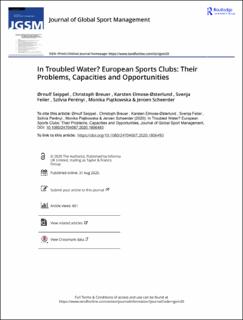| dc.contributor.author | Seippel, Ørnulf | |
| dc.contributor.author | Breuer, Christoph | |
| dc.contributor.author | Elmose-Østerlund, Karsten | |
| dc.contributor.author | Feiler, Svenja | |
| dc.contributor.author | Perényi, Szilvia | |
| dc.contributor.author | Piątkowska, Monika | |
| dc.contributor.author | Scheerder, Jeroen | |
| dc.date.accessioned | 2021-06-04T12:36:20Z | |
| dc.date.available | 2021-06-04T12:36:20Z | |
| dc.date.created | 2021-03-19T12:48:26Z | |
| dc.date.issued | 2020 | |
| dc.identifier.citation | Journal of Global Sport Management. 2020, Artikkel 1806493. | en_US |
| dc.identifier.issn | 2470-4067 | |
| dc.identifier.uri | https://hdl.handle.net/11250/2757968 | |
| dc.description | This is an Open Access article distributed under the terms of the Creative Commons Attribution-NonCommercial-NoDerivatives License (http://creativecommons.org/licenses/by-nc-nd/4.0/), which permits non-commercial re-use, distribution, and reproduction in any medium, provided the original work is properly cited, and is not altered, transformed, or built upon in any way. | en_US |
| dc.description.abstract | We study problems experienced by sports clubs from nine European countries – Belgium (Flanders), Denmark, England, Germany, Hungary, the Netherlands, Norway, Poland, and Spain – and factors – national characteristics and organizational capacities – explaining variation in problem perceptions. Data is surveys of more than 30,000 sport clubs. We investigate five types of club problems: recruitment/retention of members, recruitment/retention of volunteers at the board level, recruitment/retention of coaches/instructors, financial situation of clubs and availability of sport facilities. We found that human resource problems were widespread in Denmark and Germany and least common in Belgium. In Hungary, Poland, and Spain, finances and facilities stood out as the most reported problems. Some capacities – negative financial balance, planning capacity and social climate – have systematic and direct implications for those involved, whereas others – size and professionalization – are more difficult to interpret systematically and harder to link to strategic policy actions. | en_US |
| dc.language.iso | eng | en_US |
| dc.subject | capacities | en_US |
| dc.subject | opportunity structures | en_US |
| dc.subject | problems | en_US |
| dc.subject | resources | en_US |
| dc.subject | sports clubs | en_US |
| dc.title | In troubled water? European sports clubs: Their problems, capacities and opportunities | en_US |
| dc.type | Peer reviewed | en_US |
| dc.type | Journal article | en_US |
| dc.description.version | publishedVersion | en_US |
| dc.rights.holder | © 2020 The Author(s) | en_US |
| dc.source.pagenumber | 23 | en_US |
| dc.source.journal | Journal of Global Sport Management | en_US |
| dc.identifier.doi | 10.1080/24704067.2020.1806493 | |
| dc.identifier.cristin | 1899294 | |
| dc.description.localcode | Institutt for idrett og samfunnsvitenskap / Department of Sport and Social Sciences | en_US |
| dc.source.articlenumber | 1806493 | en_US |
| cristin.ispublished | true | |
| cristin.fulltext | original | |
| cristin.qualitycode | 1 | |
